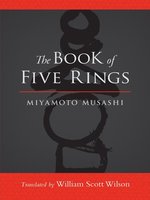From the cover
From
the Translator's Introduction
The
Book of Five Rings
and
The
Book of Family Traditions on the Art
of
War
are
two of the most important texts on conflict and strategy emerging from the
Japanese warrior culture. Originally written not only for men-at-arms, they are
explicitly intended to symbolize processes of struggle and mastery in all
concerns and walks of life.
The
Book of Five Rings
was
written in 1643 by Miyamoto Musashi, undefeated dueler, masterless samurai, and
independent teacher.
The
Book of Family Traditions on the Art of War
was
written in 1632 by Yagyu Munenori, victorious warrior, mentor of the Shogun,
and head of the Secret Service.
Both
authors were professional men-at-arms born into a long tradition of martial
culture that had ultimately come to dominate the entire body of Japanese polity
and society. Their writings are relevant not only to members of the ruling
military caste, but also to leaders in other professions, as well as people in
search of individual mastery in whatever their chosen path.
The
Book of Five Rings
and
The
Book of Family Traditions on the Art of War
are
both written in Japanese, rather than the literary Chinese customary in elite
bureaucratic, religious, and intellectual circles in Japan at that time. The
Japanese in which they are written, furthermore, is relatively uncomplicated
and quite free of the subtle complexities of classical high court Japanese.
Although the crudity of Musashi's syntax and morphology make for clumsy
reading, nevertheless the basic simplicity and deliberate clarity of both works
make them accessible to a wide and varied audience.
The
rise and empowerment of the samurai class in Japan may be seen in the two terms
used to refer to its members,
samurai
and
bushi.
The
word
samurai
comes
from the Japanese verb
saburau,
which
means "to serve as an attendant." The word
bushi
is
Sino-Japanese and means "armed gentry." The word
samurai
was
used by other social classes, while the warriors referred to themselves by the
more dignified term
bushi.
The
original samurai were attendants of nobles. In time their functions expanded to
the administration, policing, and defense of the vast estates of the nobles,
who were mostly absentee landlords. Eventually the samurai demanded and won a
greater share of the wealth and political power that the nobles had called
their own. Ultimately the military paragovernment of the Shoguns, known as the
Bakufu, or Tent Government, overshadowed the imperial organization and
dominated the whole country.
Musashi
and Yagyu lived in the founding era of the third Tent Government, which lasted
from the beginning of the seventeenth century through the middle of the
nineteenth century. While inheriting the martial traditions of its
predecessors, this third Tent Government differed notably in certain respects.
The
first Tent Government was established in eastern Japan near the end of the
twelfth century and lasted for nearly one hundred and fifty years. The warriors
of this time were descendants of noble houses, many of whom had honed their
martial skills for generations in warfare against the Ainu people in eastern
Japan. As the Tent Government was seated in Kamakura, a small town near modern
Tokyo, this period of Japanese history is commonly called the Kamakura era.
The
second Tent Government supplanted the First in 1338. The warrior class had
expanded and become more differentiated by this time, with lesser and thinner
genealogical ties to the ancient aristocracy. The Shoguns of this period
established their Tent Government in...





